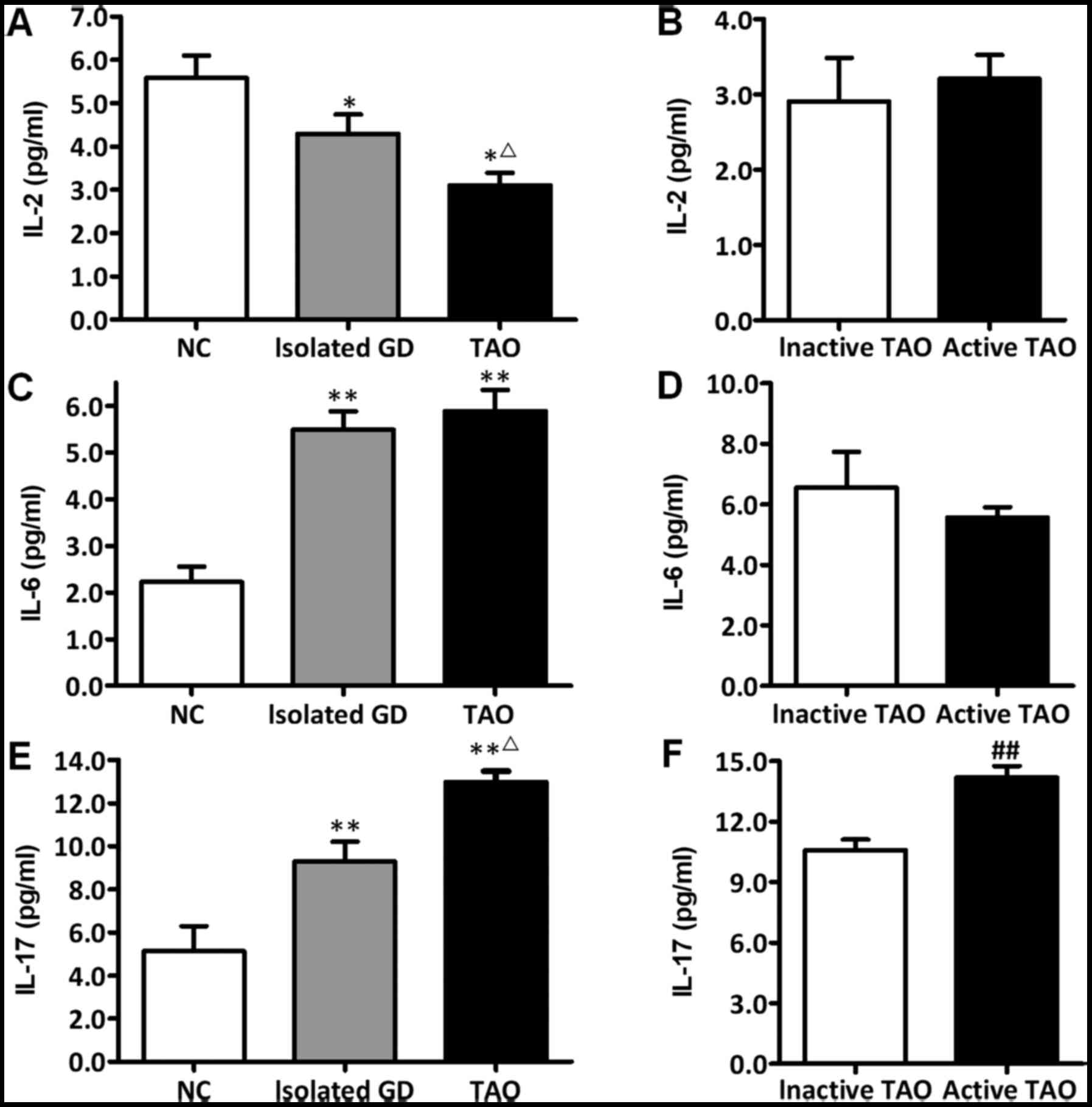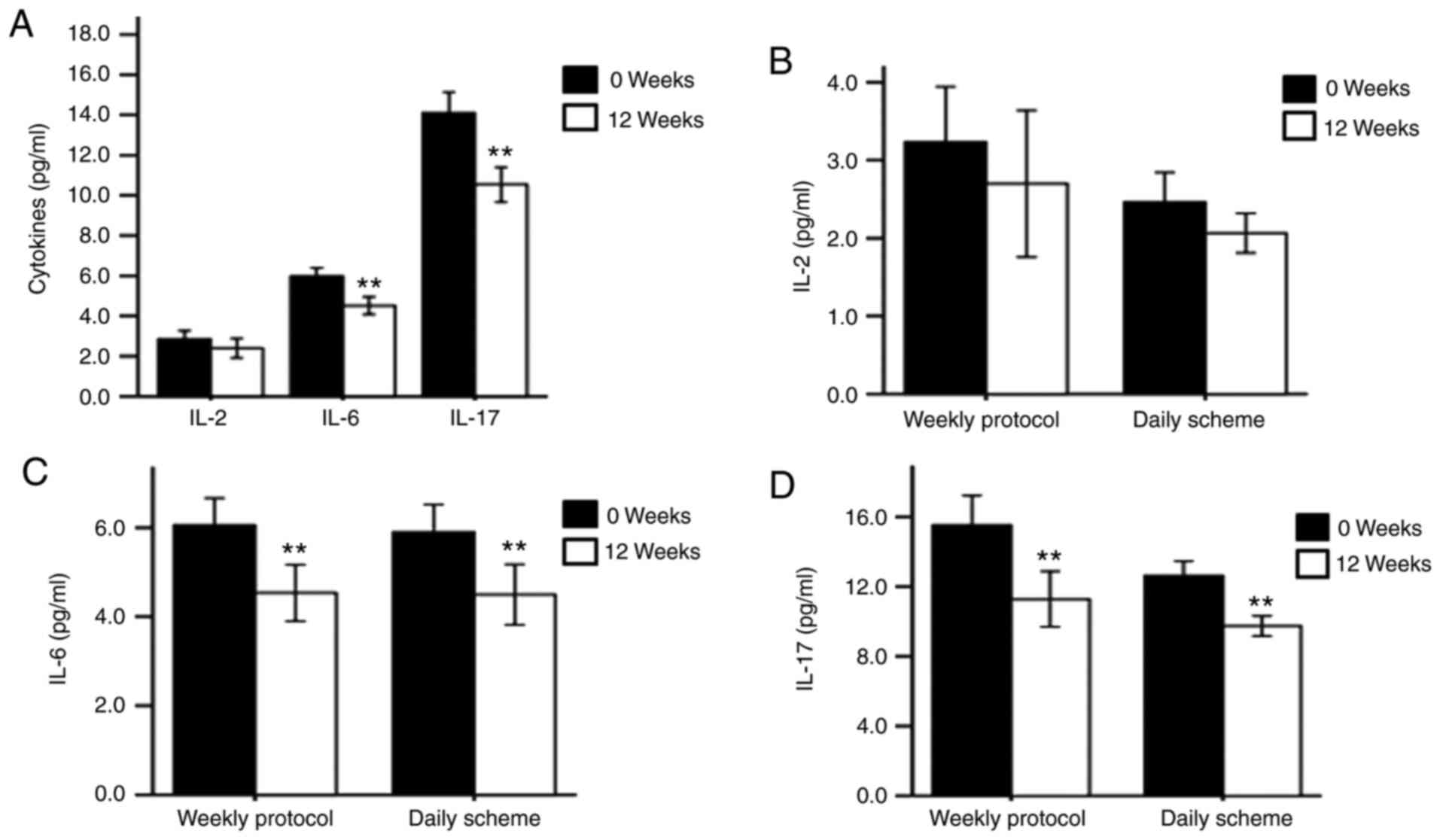|
1
|
Bartalena L, Pinchera A and Marcocci C:
Management of Graves' ophthalmopathy: Reality and perspectives.
Endocr Rev. 21:168–199. 2000.PubMed/NCBI View Article : Google Scholar
|
|
2
|
Gao G, Dai J, Qian Y and Ma F:
Meta-analysis of methylprednisolone pulse therapy for Graves'
ophthalmopathy. Clin Exp Ophthalmol. 42:769–777. 2014.PubMed/NCBI View Article : Google Scholar
|
|
3
|
Bartalena L, Baldeschi L, Dickinson AJ,
Eckstein A, Kendall-Taylor P, Marcocci C, Mourits MP, Perros P,
Boboridis K, Boschi A, et al: Consensus statement of the European
group on Graves' orbitopathy (EUGOGO) on management of Graves'
orbitopathy. Thyroid. 18:333–346. 2008.PubMed/NCBI View Article : Google Scholar
|
|
4
|
Zhu W, Ye L, Shen L, Jiao Q, Huang F, Han
R, Zhang X, Wang S, Wang W and Ning G: A prospective, randomized
trial of intravenous glucocorticoids therapy with different
protocols for patients with Graves' ophthalmopathy. J Clin
Endocrinol Metab. 99:1999–2007. 2014.PubMed/NCBI View Article : Google Scholar
|
|
5
|
Zang S, Ponto KA and Kahaly GJ: Clinical
review: Intravenous glucocorticoids for Graves' orbitopathy:
Efficacy and morbidity. J Clin Endocrinol Metab. 96:320–332.
2011.PubMed/NCBI View Article : Google Scholar
|
|
6
|
Tsai CC, Kau HC, Kao SC and Hsu WM:
Exophthalmos of patients with Graves' disease in Chinese of Taiwan.
Eye (Lond). 20:569–573. 2006.PubMed/NCBI View Article : Google Scholar
|
|
7
|
Mourits MP, Koornneef L, Wiersinga WM,
Prummel MF, Berghout A and van der Gaag R: Clinical criteria for
the assessment of disease activity in Graves' ophthalmopathy: A
novel approach. Br J Ophthalmol. 73:639–644. 1989.PubMed/NCBI View Article : Google Scholar
|
|
8
|
Bartalena L, Marcocci C, Bogazzi F,
Manetti L, Tanda ML, Dell'Unto E, Bruno-Bossio G, Nardi M,
Bartolomei MP, Lepri A, et al: Relation between therapy for
hyperthyroidism and the course of Graves' ophthalmopathy. N Engl J
Med. 338:73–78. 1989.PubMed/NCBI View Article : Google Scholar
|
|
9
|
Modjtahedi SP, Modjtahedi BS, Mansury AM,
Selva D, Douglas RS, Goldberg RA and Leibovitch I: Pharmacological
treatments for thyroid eye disease. Drugs. 66:1685–1700.
2006.PubMed/NCBI View Article : Google Scholar
|
|
10
|
Marcocci C, Bartalena L, Tanda ML, Manetti
L, Dell'Unto E, Rocchi R, Barbesino G, Mazzi B, Bartolomei MP,
Lepri P, et al: Comparison of the effectiveness and tolerability of
intravenous or oral glucocorticoids associated with orbital
radiotherapy in the management of severe Graves' ophthalmopathy:
Results of a prospective, single-blind, randomized study. J Clin
Endocrinol Metab. 86:3562–3567. 2001.PubMed/NCBI View Article : Google Scholar
|
|
11
|
Macchia PE, Bagattini M, Lupoli G, Vitale
M, Vitale G and Fenzi G: High-dose intravenous corticosteroid
therapy for Graves' ophthalmopathy. J Endocrinol Invest.
24:152–158. 2001.PubMed/NCBI View Article : Google Scholar
|
|
12
|
Kauppinen-Makelin R, Karma A, Leinonen E,
Loyttyniemi E, Salonen O, Sane T, Setala K, Viikari J, Heufelder A
and Valimaki M: High dose intravenous methylprednisolone pulse
therapy versus oral prednisone for thyroid-associated
ophthalmopathy. Acta Ophthalmol Scand. 80:316–321. 2002.PubMed/NCBI View Article : Google Scholar
|
|
13
|
Kahaly GJ, Pitz S, Hommel G and Dittmar M:
Randomized, single blind trial of intravenous versus oral steroid
monotherapy in Graves' orbitopathy. J Clin Endocrinol Metab.
90:5234–5240. 2005.PubMed/NCBI View Article : Google Scholar
|
|
14
|
van Geest RJ, Sasim IV, Koppeschaar HP,
Kalmann R, Stravers SN, Bijlsma WR and Mourits MP:
Methylprednisolone pulse therapy for patients with moderately
severe Graves' orbitopathy: A prospective, randomized,
placebo-controlled study. Eur J Endocrinol. 158:229–237.
2008.PubMed/NCBI View Article : Google Scholar
|
|
15
|
Ng CM, Yuen HK, Choi KL, Chan MK, Yuen KT,
Ng YW and Tiu SC: Combined orbital irradiation and systemic
steroids compared with systemic steroids alone in the management of
moderate-to-severe Graves' ophthalmopathy: A preliminary study.
Hong Kong Med J. 11:322–330. 2005.PubMed/NCBI
|
|
16
|
Aktaran S, Akarsu E, Erbağci I, Araz M,
Okumus S and Kartal M: Comparison of intravenous methylprednisolone
therapy vs. oral methylprednisolone therapy in patients with
Graves' ophthalmopathy. Int J Clin Pract. 61:45–51. 2007.PubMed/NCBI View Article : Google Scholar
|
|
17
|
Huang Y, Fang S, Li D, Zhou H, Li B and
Fan X: The involvement of T cell pathogenesis in thyroid-associated
ophthalmopathy. Eye (Lond). 33:176–182. 2019.PubMed/NCBI View Article : Google Scholar
|
|
18
|
Khong JJ, McNab AA, Ebeling PR, Craig JE
and Selva D: Pathogenesis of thyroid eye disease: Review and update
on molecular mechanisms. Br J Ophthalmol. 100:142–150.
2016.PubMed/NCBI View Article : Google Scholar
|
|
19
|
Gianoukakis AG, Khadavi N and Smith TJ:
Cytokines, Graves' disease, and thyroid-associated ophthalmopathy.
Thyroid. 18:953–958. 2008.PubMed/NCBI View Article : Google Scholar
|
|
20
|
Douglas RS and Gupta S: The
pathophysiology of thyroid eye disease: Implications for
immunotherapy. Curr Opin Ophthalmol. 22:385–390. 2011.PubMed/NCBI View Article : Google Scholar
|
|
21
|
Mills KH: Induction, function and
regulation of IL-17-producing T cells. Eur J Immunol. 38:2636–2649.
2008.PubMed/NCBI View Article : Google Scholar
|
|
22
|
Ziolkowska M, Koc A, Luszczykiewicz G,
Ksiezopolska-Pietrzak K, Klimczak E, Chwalinska-Sadowska H and
Maslinski W: High levels of IL-17 in rheumatoid arthritis patients:
IL-15 triggers in vitro IL-17 production via cyclosporin
A-sensitive mechanism. J Immunol. 164:2832–2838. 2000.PubMed/NCBI View Article : Google Scholar
|
|
23
|
Nalbandian A, Crispin JC and Tsokos GC:
Interleukin-17 and systemic lupus erythematosus: Current concepts.
Clin Exp Immunol. 157:209–215. 2009.PubMed/NCBI View Article : Google Scholar
|
|
24
|
Yang D, Hiromatsu Y, Hoshino T, Inoue Y,
Itoh K and Nonaka K: Dominant infiltration of T(H)1-type CD4+ T
cells at the retrobulbar space of patients with thyroid-associated
ophthalmopathy. Thyroid. 9:305–310. 1999.PubMed/NCBI View Article : Google Scholar
|
|
25
|
Aniszewski JP, Valyasevi RW and Bahn RS:
Relationship between disease duration and predominant orbital T
cell subset in Graves' ophthalmopathy. J Clin Endocrinol Metab.
85:776–780. 2000.PubMed/NCBI View Article : Google Scholar
|
|
26
|
Wakelkamp IM, Bakker O, Baldeschi L,
Wiersinga WM and Prummel MF: TSH-R expression and cytokine profile
in orbital tissue of active vs. inactive Graves' ophthalmopathy
patients. Clin Endocrinol (Oxf). 58:280–287. 2003.PubMed/NCBI View Article : Google Scholar
|
|
27
|
Hiromatsu Y, Kaku H, Miyake I, Murayama S
and Soejima E: Role of cytokines in the pathogenesis of
thyroid-associated ophthalmopathy. Thyroid. 12:217–221.
2002.PubMed/NCBI View Article : Google Scholar
|
|
28
|
Avunduk AM, Avunduk MC, Pazarli H, Oguz V,
Varnell ED, Kaufman HE and Aksoy F: Immunohistochemical analysis of
orbital connective tissue specimens of patients with active Graves
ophthalmopathy. Curr Eye Res. 30:631–638. 2005.PubMed/NCBI View Article : Google Scholar
|
|
29
|
Lacka K, Manuszewska E, Korczowska I and
Lacki JK: The effect of methylprednisolone pulse treatment on
cytokine network in Graves ophthalmopathy. Curr Eye Res.
32:291–297. 2007.PubMed/NCBI View Article : Google Scholar
|
|
30
|
Esfahanian F, Naimi E, Doroodgar F and
Jadali Z: Th1/Th2 cytokines in patients with Graves' disease with
or without ophthalmopathy. Iran J Allergy Asthma Immunol.
12:168–175. 2013.PubMed/NCBI
|
|
31
|
Shen J, Li Z, Li W, Ge Y, Xie M, Lv M, Fan
Y, Chen Z, Zhao D and Han Y: Th1, th2, and th17 cytokine
involvement in thyroid associated ophthalmopathy. Dis Markers.
2015(609593)2015.PubMed/NCBI View Article : Google Scholar
|
|
32
|
Kim SE, Yoon JS, Kim KH and Lee SY:
Increased serum interleukin-17 in Graves' ophthalmopathy. Graefes
Arch Clin Exp Ophthalmol. 250:1521–1526. 2012.PubMed/NCBI View Article : Google Scholar
|
|
33
|
Peng D, Xu B, Wang Y, Guo H and Jiang Y: A
high frequency of circulating th22 and th17 cells in patients with
new onset Graves' disease. PLoS One. 8(e68446)2013.PubMed/NCBI View Article : Google Scholar
|
|
34
|
Li JR, Hong FY, Zeng JY and Huang GL:
Functional interleukin-17 receptor A are present in the thyroid
gland in intractable Graves disease. Cell Immunol. 281:85–90.
2013.PubMed/NCBI View Article : Google Scholar
|
|
35
|
Figueroa-Vega N, Alfonso-Perez M,
Benedicto I, Sanchez-Madrid F, Gonzalez-Amaro R and Marazuela M:
Increased circulating pro-inflammatory cytokines and Th17
lymphocytes in Hashimoto's thyroiditis. J Clin Endocrinol Metab.
95:953–962. 2010.PubMed/NCBI View Article : Google Scholar
|
|
36
|
Horie I, Abiru N, Saitoh O, Ichikawa T,
Iwakura Y, Eguchi K and Nagayama Y: Distinct role of T helper Type
17 immune response for Graves' hyperthyroidism in mice with
different genetic backgrounds. Autoimmunity. 44:159–165.
2011.PubMed/NCBI View Article : Google Scholar
|
|
37
|
Inoue N, Watanabe M, Nanba T, Wada M,
Akamizu T and Iwatani Y: Involvement of functional polymorphisms in
the TNFA gene in the pathogenesis of autoimmune thyroid diseases
and production of anti-thyrotropin receptor antibody. Clin Exp
Immunol. 156:199–204. 2009.PubMed/NCBI View Article : Google Scholar
|
|
38
|
Bedoya SK, Lam B, Lau K and Larkin J III:
Th17 cells in immunity and autoimmunity. Clin Dev Immunol.
2013(986789)2013.PubMed/NCBI View Article : Google Scholar
|
















